How to Use AI to Write Emails (With Prompts)
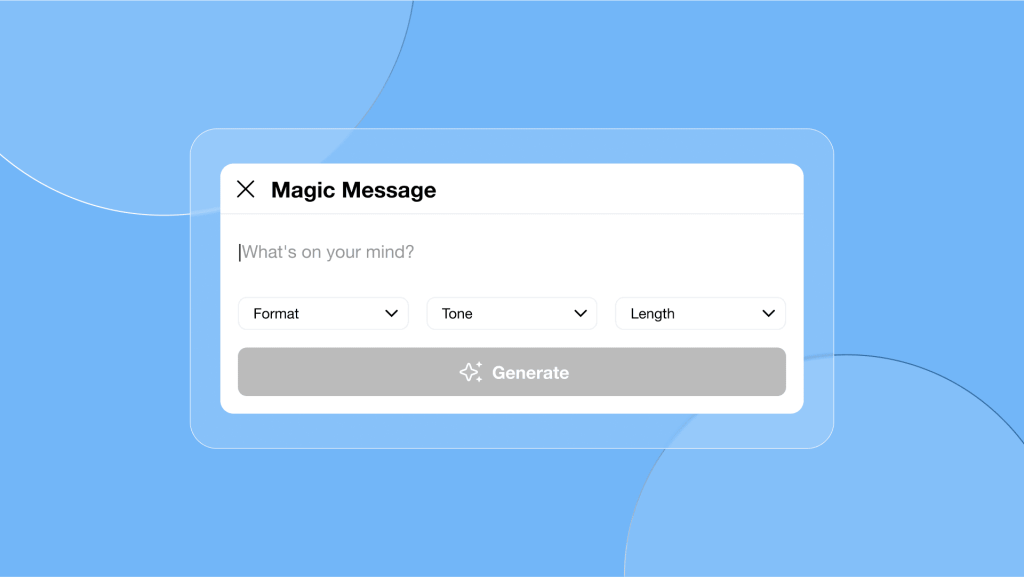
You know what you want to say, but figuring out how to say it right can feel challenging. That’s where AI steps in. With the right tools, AI can generate flawless emails in seconds, saving you valuable time and effort.
But how do you ensure AI captures your tone and intent perfectly every time?
This guide is your blueprint for using AI to transform your email writing. We’ll explore:
- The best AI tools to boost your productivity.
- How to craft effective prompts.
- Useable prompt templates for every occasion.
By the end, you’ll have everything you need to turn AI into your email assistant and make every message clear, engaging, and impactful.
Benefits of Using AI for Email Writing
AI makes email writing faster, easier, and more effective, taking the stress out of every step:
- Save time and effort: With AI, you can draft an entire email in a few seconds. Especially useful for the more routine emails, like follow-ups, confirmations, etc.
- Perfect the tone: Instead of second-guessing your wording, just specify the tone you need in your prompt, and AI delivers a draft that’s exactly right.
- Eliminate errors: Avoid the embarrassment of typos or grammar mistakes. AI scans for errors to ensure every email is polished and professional.
- Personalize with precision: AI tailors your email to the recipient. It uses personal details like names, locations, or events to make every message feel custom.
- Craft attention-grabbing subject lines: AI suggests subject lines based on proven success patterns to boost open rates and engagement.
In short, AI simplifies email writing so you can focus on building connections and achieving results.
How Prompts Work for AI Email Writing
How you phrase your prompt directly impacts the quality of the email AI produces. A clear and specific prompt guides the AI in crafting a response that fits your tone and purpose. On the other hand, a vague or poorly worded prompt can lead to results that miss the mark.
Here’s an example:
- Vague prompt: “Write an email about rescheduling.”
Output: A generic message that might not include the details you need.
- Specific prompt: “Write a polite email to my client rescheduling our meeting from Monday to Wednesday at 3 PM. Keep it professional but approachable.”
Output: A well-crafted email tailored to your exact request.
The clearer your instructions are, the better the results will be, helping you save time and avoid frustration.
How to Craft the Perfect AI Email Prompt
-
Be clear about the purpose
- Specify what the email is for: follow-up, invitation, thank-you, etc.
- Example: “Write a follow-up email thanking the client for attending the meeting and suggesting a follow-up call next week.”
-
Provide relevant context
- Include details like names, dates, or previous interactions.
- Example: “Mention the discussion we had during our meeting on Tuesday about project deadlines.”
-
Set the tone
- Indicate the tone you want: formal, friendly, concise, etc.
- Example: “Use a professional and respectful tone.”
-
Add a clear call-to-action
- State what the recipient should do after reading.
- Example: “Encourage them to confirm the meeting by replying with their availability.”
-
Specify structure or style
- Ask for specific formatting or phrasing if needed.
- Example: “Organize the points in bullet format.”
-
Refine for better results
- Adjust prompts to improve clarity or tweak the response.
- Example: “Make it more concise and add a friendly closing line.”
How to Write Emails Using AI
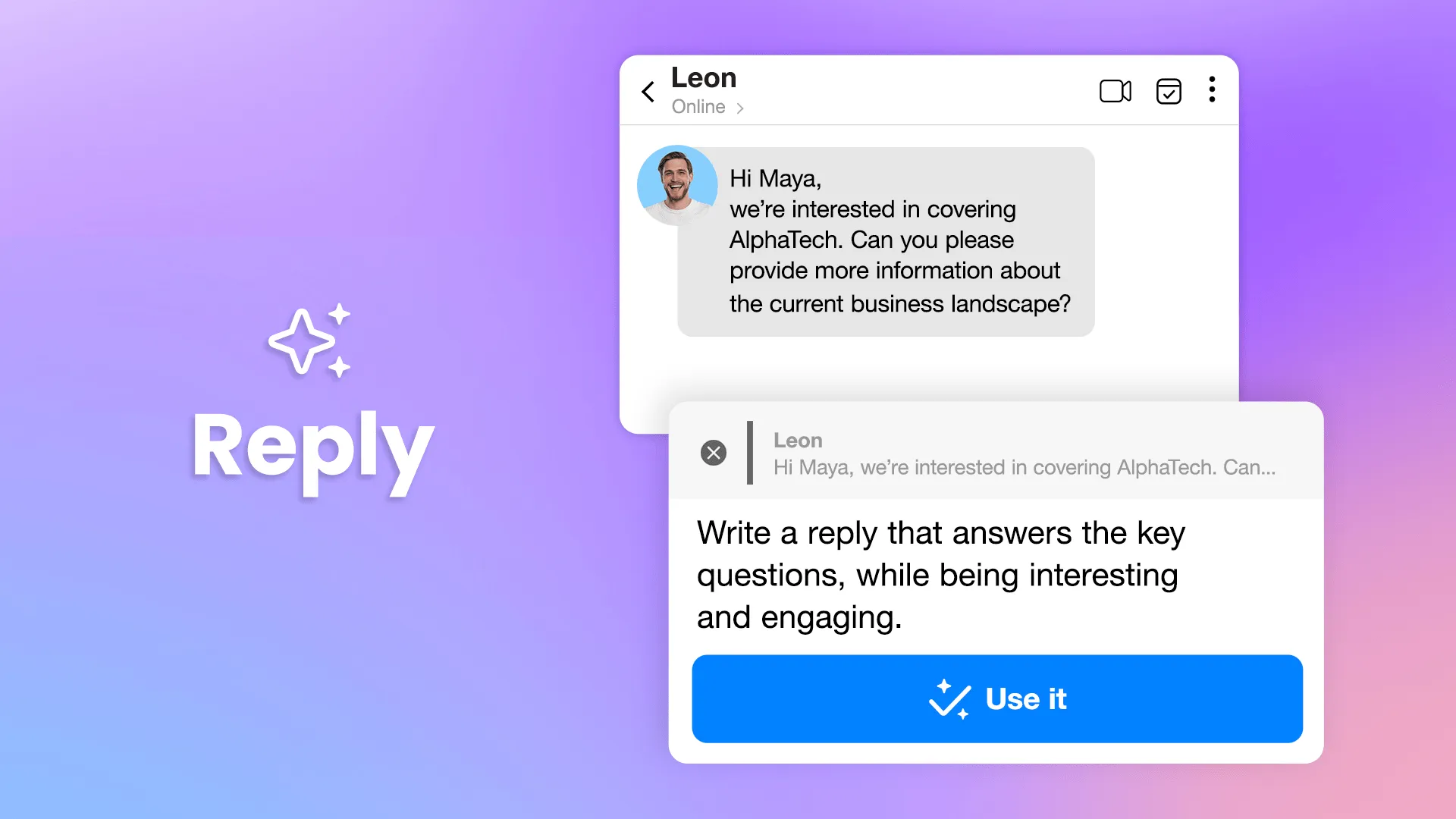
Spike’s AI makes email writing easier by helping you overcome common challenges like tone, phrasing, typos, and clarity. Here’s a step-by-step guide to using it:
1. Generate an email draft
- Open the composer to write a new email or reply to an existing one.
- Enter your main points or ideas in the input field.
- Specify the tone (e.g., formal, friendly) and length you want.
- Click to generate the draft.
- Review and tweak the draft as needed, then insert it into your email.
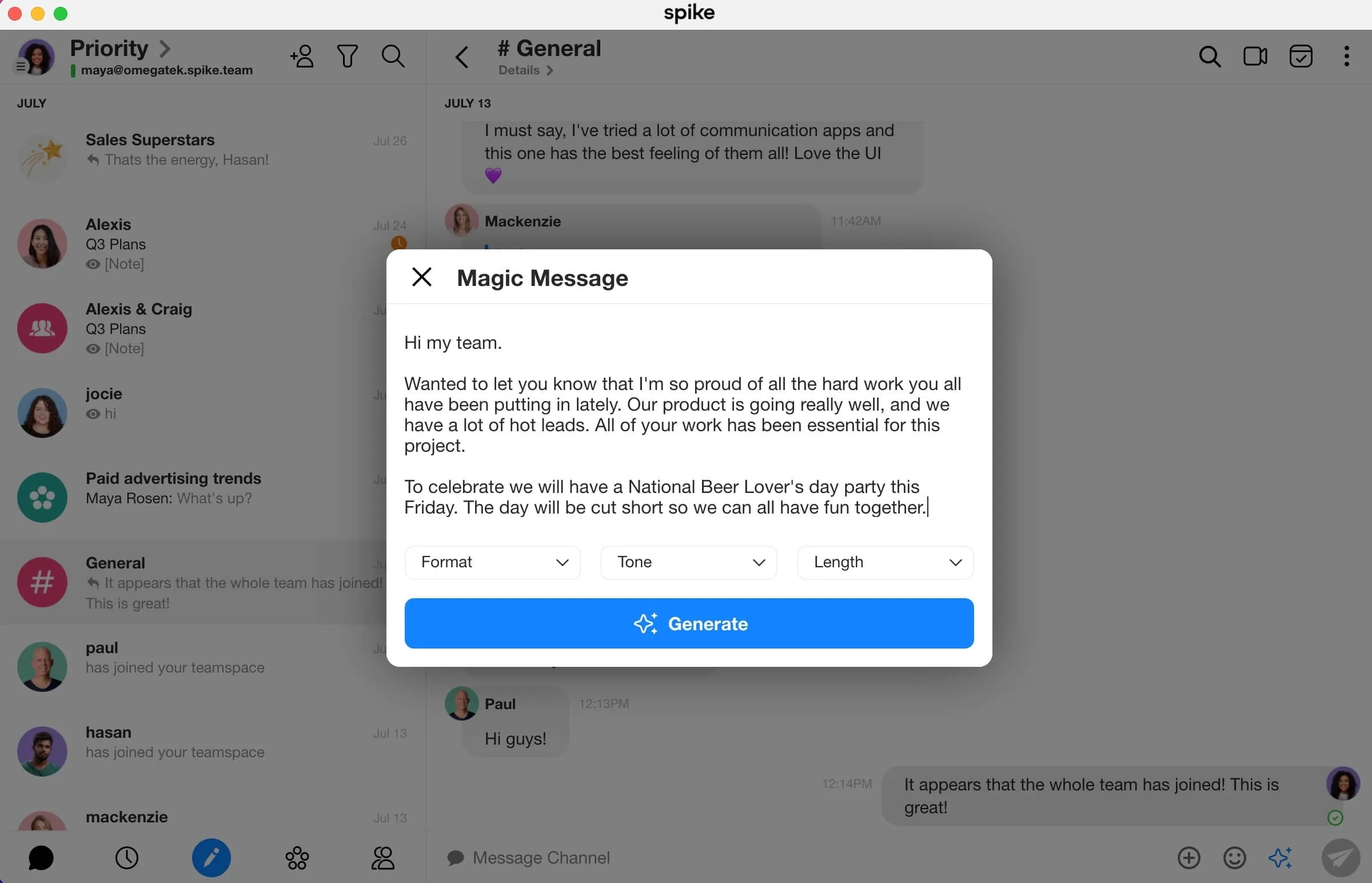
2. Refine emails for clarity and tone
- Highlight your email text.
- Choose to refine the tone, grammar, or phrasing.
- Apply the changes directly to your email.
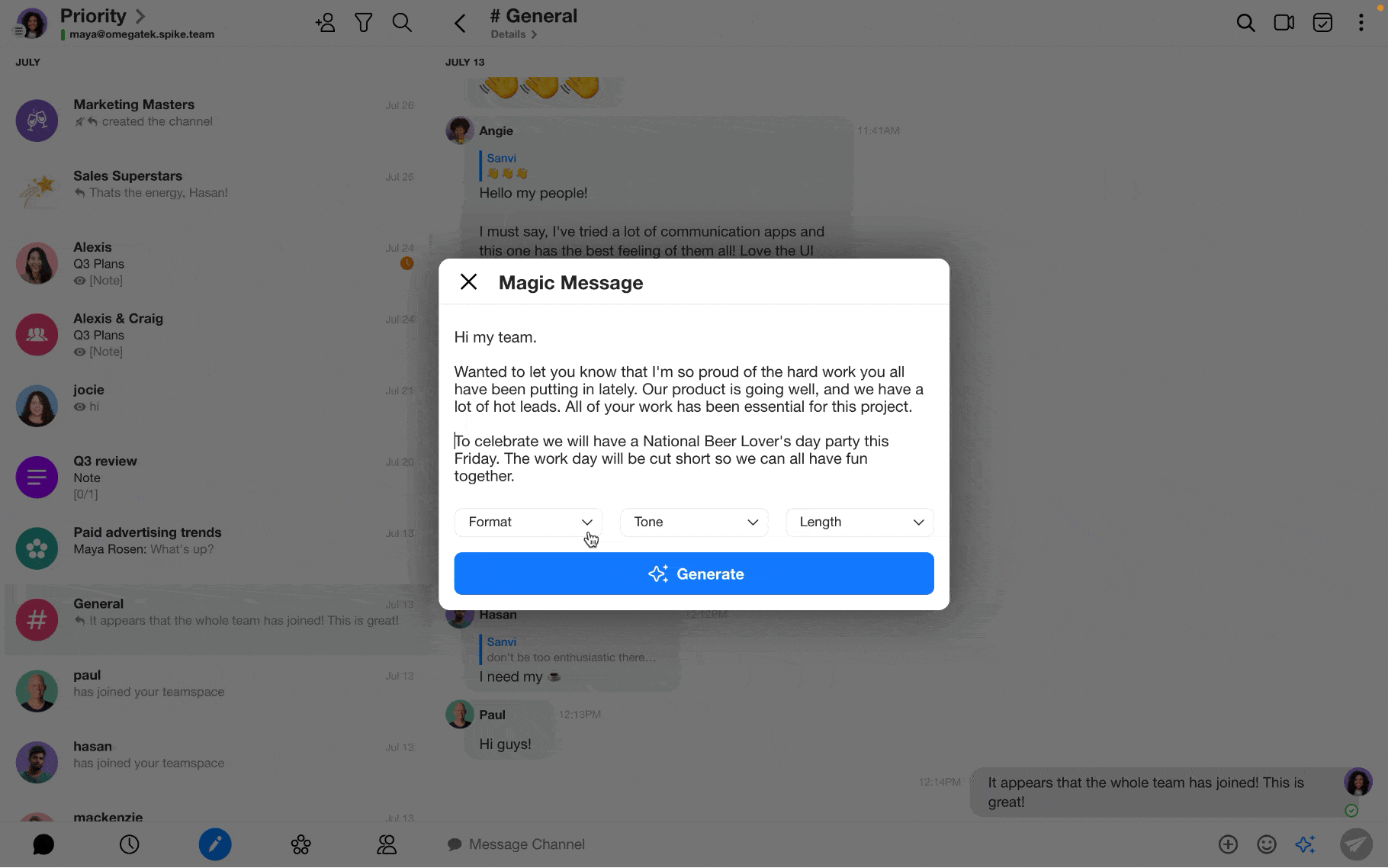
Note:
You can also use Spike’s AI to summarize email threads. Just click on the purple banner at the top of the thread, and you’ll get a concise summary of the whole conversation.
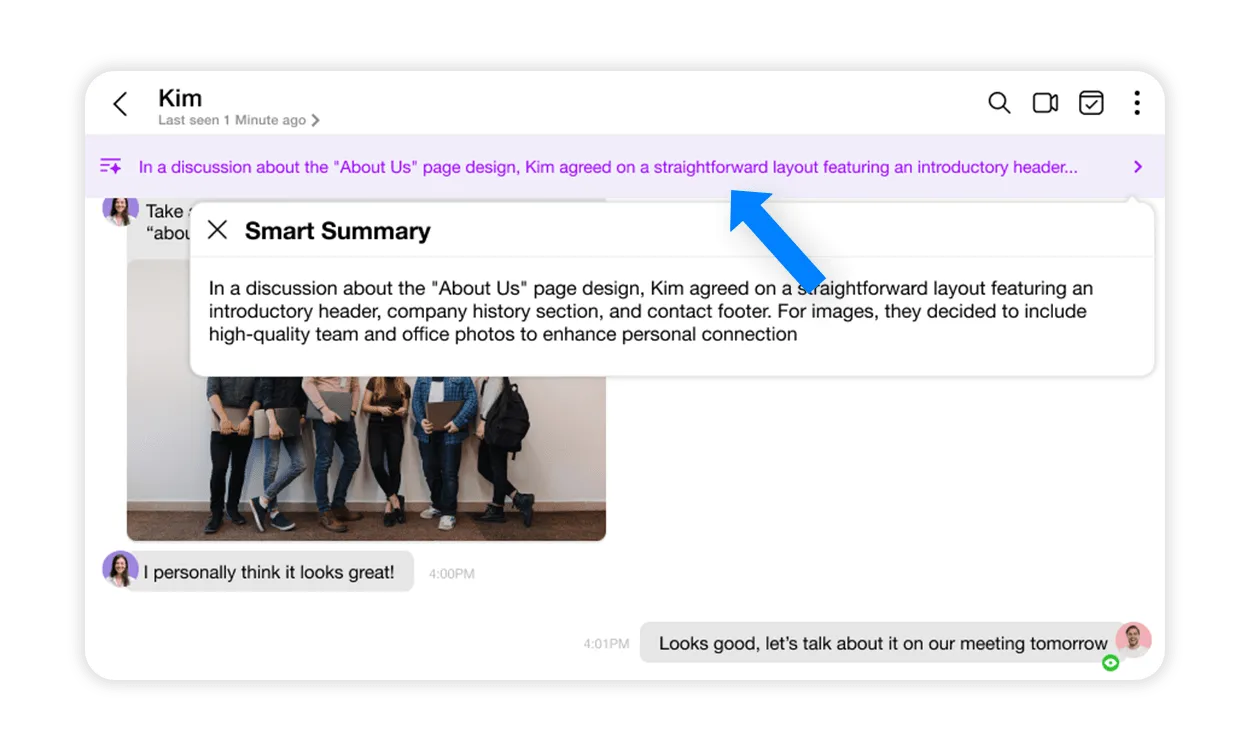
50+ Ready-to-use AI email prompts
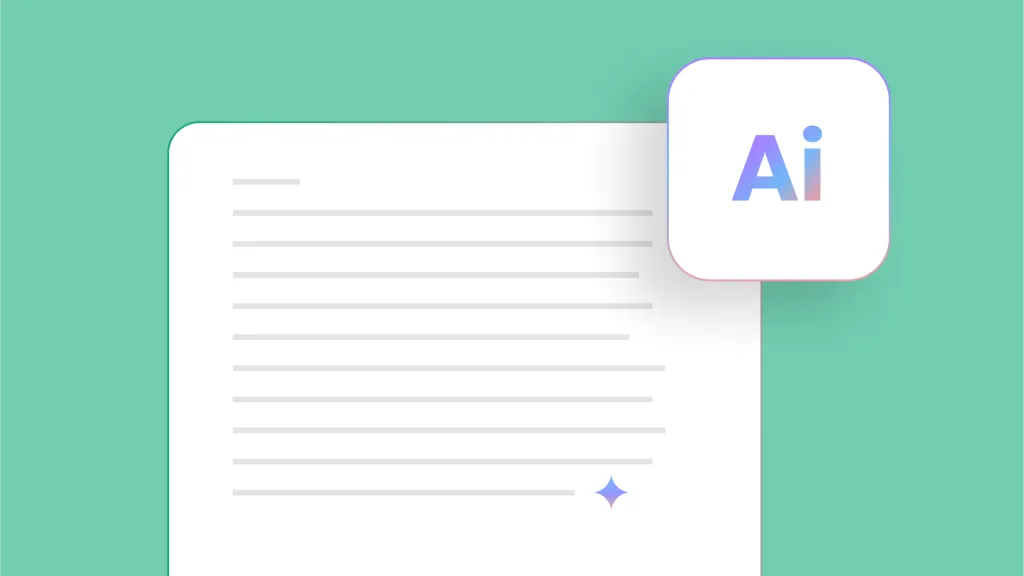
Use these as templates to generate flawless emails. Just add details like recipient names, dates, or company specifics to make each prompt work for you.
For professional and business communication
- “Compose a formal meeting request to discuss [project topic] on [date].”
- “Write a follow-up email to [name] thanking them for the meeting and summarizing the next steps.”
- “Introduce myself to [name] and explain my role in [company].”
- “Send a formal thank-you email to [name] for their support on [project].”
- “Update [team/client] on the progress of [project], including any upcoming deadlines.”
- “Request feedback from [name] on our recent proposal.”
- “Send a reminder about the upcoming project deadline on [date].”
- “Summarize our project goals and ask for additional input from team members.”
For sales and marketing emails
- “Draft a product promotion email highlighting the benefits of [product/service].”
- “Create an event invitation for [event name] on [date] with a registration link.”
- “Request feedback from customers who recently purchased [product/service].”
- “Write a subscription renewal reminder for [product/service] with renewal options.”
- “Follow up with [prospect’s name] to discuss our sales proposal.”
- “Introduce a new feature of [product] and encourage engagement.”
- “Encourage past customers to check out our seasonal sale.”
- “Request a testimonial from a satisfied client about [product/service].”
For customer support and service
- “Compose a response to a customer complaint about [issue], offering a solution.”
- “Draft a refund notice for [product/service], explaining the refund process.”
- “Send a service renewal reminder for [product/service] with renewal details.”
- “Request feedback on their recent support experience with us.”
- “Inform customers about an update to [product/service] and its benefits.”
- “Offer a discount as compensation for a service disruption on [date].”
- “Explain the steps needed to resolve a customer’s issue with [product/service].”
- “Thank the customer for their patience during a support process and provide updates.”
For internal team communications
- “Announce a policy update to the team, outlining key changes and actions required.”
- “Introduce [new employee name] to the team, mentioning their role and responsibilities.”
- “Send a reminder about the upcoming team meeting on [date] with an agenda.”
- “Provide a project status update to the department, highlighting recent progress.”
- “Announce the date and details of the upcoming company event.”
- “Inform team members about a change in project timeline.”
- “Share end-of-quarter results and key takeaways for the team.”
- “Encourage team members to submit feedback on recent initiatives.”
For networking and outreach
- “Draft a LinkedIn connection request to [name] with a personalized note.”
- “Request an informational interview with [name] to learn about their role in [field].”
- “Follow up with [name] after [event name], expressing interest in future collaboration.”
- “Request a referral from [contact name] for a potential opportunity at [company].”
- “Introduce myself to [name] through [mutual contact’s name] with a brief background.”
- “Congratulate [name] on their recent promotion and express interest in reconnecting.”
- “Reach out to [name] to explore potential partnership opportunities.”
- “Express gratitude to [name] for recent insights shared at [event name].”
For human resources and recruitment
- “Write a job offer letter for the position of [job title], including key employment terms.”
- “Invite [candidate name] to interview for [job title] on [date].”
- “Send a rejection email to [candidate name] after their recent interview.”
- “Draft a new hire onboarding email for [new employee’s name] with initial instructions.”
- “Provide performance feedback to [employee name], recognizing achievements and areas for growth.”
- “Notify candidates of interview results and next steps in the hiring process.”
- “Share employee development opportunities with the team.”
- “Send a reminder to employees about an upcoming HR survey.”
For personal and social emails
- “Write a thank-you note to [name] for their recent help with [event/activity].”
- “Send a congratulatory email to [name] for their recent achievement.”
- “Apologize to [name] for any misunderstanding and offer a follow-up.”
- “Respond to an RSVP invitation from [name] for [event name].”
- “Write a friendly birthday greeting for [name].”
- “Thank [name] for hosting and express appreciation for their hospitality.”
- “Express excitement about reconnecting with [name] after a long time.”
- “Acknowledge [name’s] recent milestone with a personal congratulatory message.”
These prompts are designed to adapt to your needs, ensuring that your AI-generated emails are polished, targeted, and impactful.
Wrap-Up
AI tools have reshaped the email landscape, bringing efficiency and personalization to what was once a time-consuming process. From composing quick replies to crafting detailed follow-ups, AI now makes email communication more effective and effortless.
You can easily elevate your email game by understanding key tools, mastering prompt engineering, and learning about AI’s underlying technology.
Spike Magic AI is an excellent solution for anyone looking to streamline email management while improving quality. With its powerful, integrated AI capabilities, Spike makes creating high-quality, context-aware emails in your inbox easy.
Try it out and experience firsthand how AI can transform your email workflow into something faster, smarter, and more impactful.




